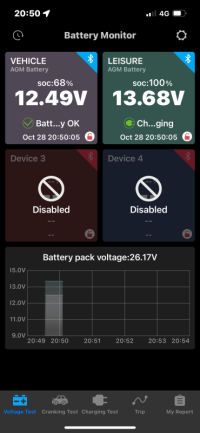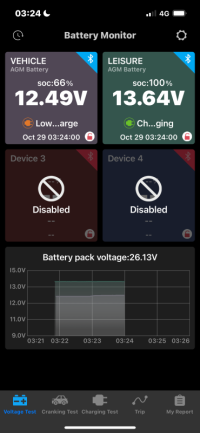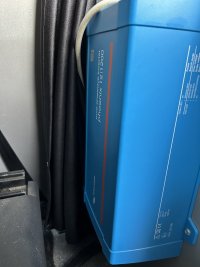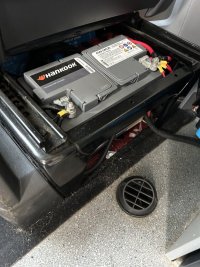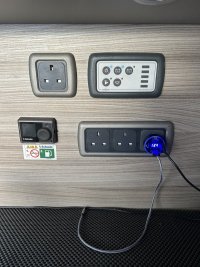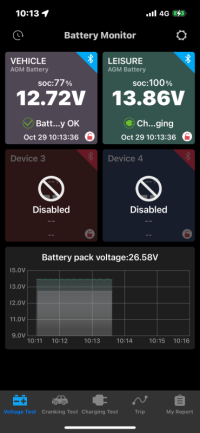I fitted one of these (used to be in our old motorhome) and have to date never had a problem with vehicle battery no matter how long we are off grid.
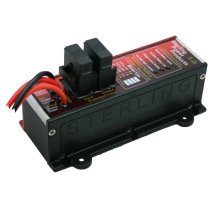
Why use this product instead of a voltage sensitive relay?
A voltage sensitive relay takes a relatively large amount of charge to hold in a relay. This is power you cannot afford if you are only producing low current (e.g. from solar / wind input). The Battery Maintainer uses FETs instead of relays and as such uses very little power itself (less than 1 mA) thus solar input can be more efficiently used. The Maintainer is also current limiting so the high load on starting would not affect it. Relays also have a limited life cycle and on low power generation a relay could be clicking ‘on’ and ‘off’ all day. However, with a FET control system there is no physical contacts to wear out and no noise produced. This Maintainer should not be used on a battery with a sustained heavy discharge/drain as it can’t pass high currents. See Voltage Sensitive Relays or the Battery to Battery Chargers section.
A 100Ah battery at 50% discharge would take about 24-36 hours.
How does it work?
This unit is activated when the main battery has reached about 13.3V and allows excess power to be transferred from the primary charging system to charge / maintain an auxiliary battery bank.
Please note that this product has no fast charge / boost ability but simply mirrors the input voltage with a small voltage drop (depending on the current flow), the final charge voltage would be around 0.2V lower than the primary charge voltage. This is more than enough to keep a battery topped up and supply any small loads, such as: the battery internal discharge and the engine management system discharge (up to about 1A continuous). This product should not be used on a battery with a sustained heavy discharge or drain as it does not have the ability to pass high currents, for higher currents see the Voltage Sensitive Relays or the Battery to Battery Chargers sections of the catalogue.
This maintainer has the ability to charge and maintain the charge, even if the battery is low (in a long time frame for example a 100A battery at 50% discharge could take about 1-2 days) it would never do this if the current discharge from that battery is in excess of 2A.
I have it connect to my 180amp battery and feeding vehicle battery, so keeps it charged up. Not cheap, but better than replacing battery if setup not right.
Look here: Link

Why use this product instead of a voltage sensitive relay?
A voltage sensitive relay takes a relatively large amount of charge to hold in a relay. This is power you cannot afford if you are only producing low current (e.g. from solar / wind input). The Battery Maintainer uses FETs instead of relays and as such uses very little power itself (less than 1 mA) thus solar input can be more efficiently used. The Maintainer is also current limiting so the high load on starting would not affect it. Relays also have a limited life cycle and on low power generation a relay could be clicking ‘on’ and ‘off’ all day. However, with a FET control system there is no physical contacts to wear out and no noise produced. This Maintainer should not be used on a battery with a sustained heavy discharge/drain as it can’t pass high currents. See Voltage Sensitive Relays or the Battery to Battery Chargers section.
A 100Ah battery at 50% discharge would take about 24-36 hours.
How does it work?
This unit is activated when the main battery has reached about 13.3V and allows excess power to be transferred from the primary charging system to charge / maintain an auxiliary battery bank.
Please note that this product has no fast charge / boost ability but simply mirrors the input voltage with a small voltage drop (depending on the current flow), the final charge voltage would be around 0.2V lower than the primary charge voltage. This is more than enough to keep a battery topped up and supply any small loads, such as: the battery internal discharge and the engine management system discharge (up to about 1A continuous). This product should not be used on a battery with a sustained heavy discharge or drain as it does not have the ability to pass high currents, for higher currents see the Voltage Sensitive Relays or the Battery to Battery Chargers sections of the catalogue.
This maintainer has the ability to charge and maintain the charge, even if the battery is low (in a long time frame for example a 100A battery at 50% discharge could take about 1-2 days) it would never do this if the current discharge from that battery is in excess of 2A.
I have it connect to my 180amp battery and feeding vehicle battery, so keeps it charged up. Not cheap, but better than replacing battery if setup not right.
Look here: Link
Last edited:


